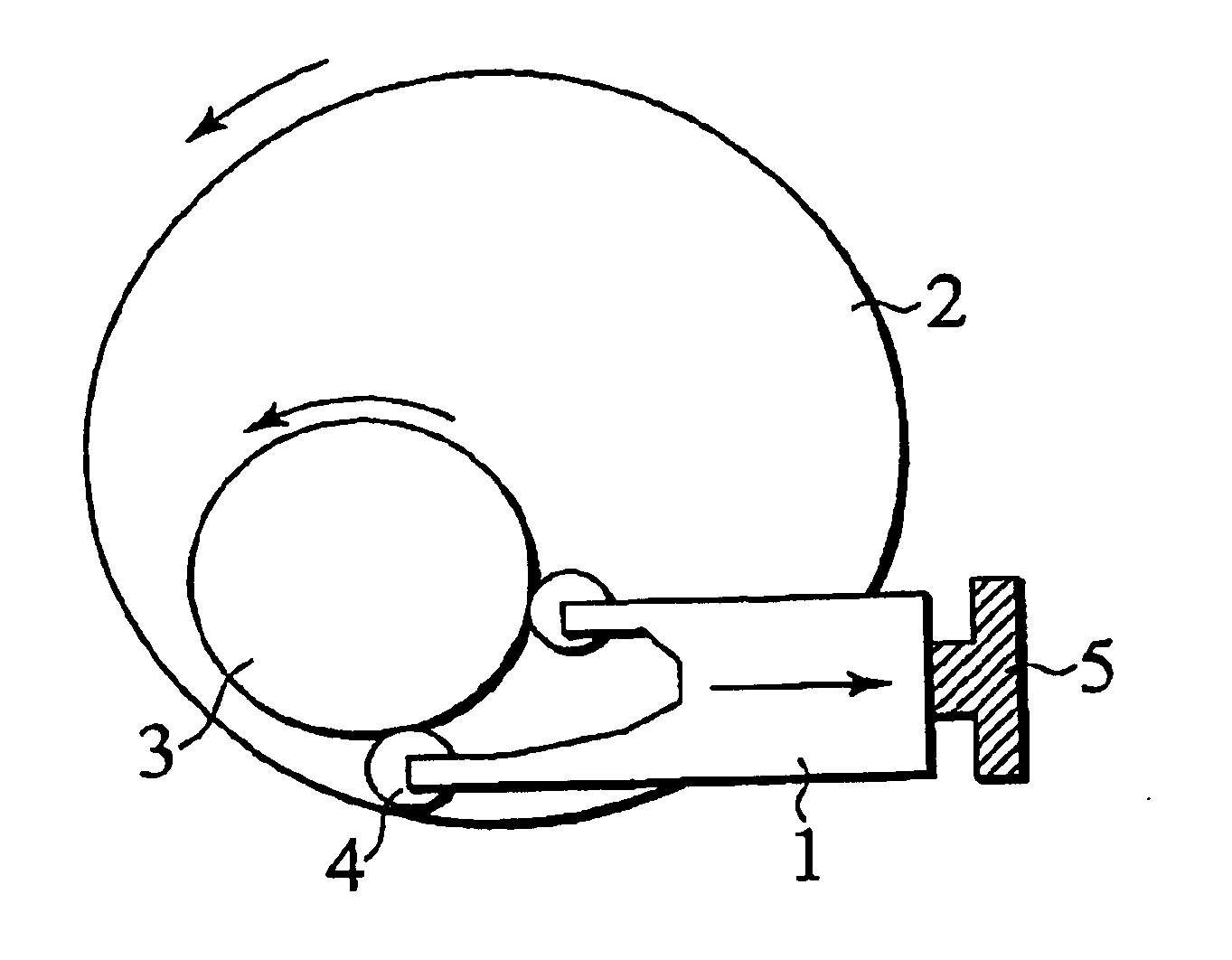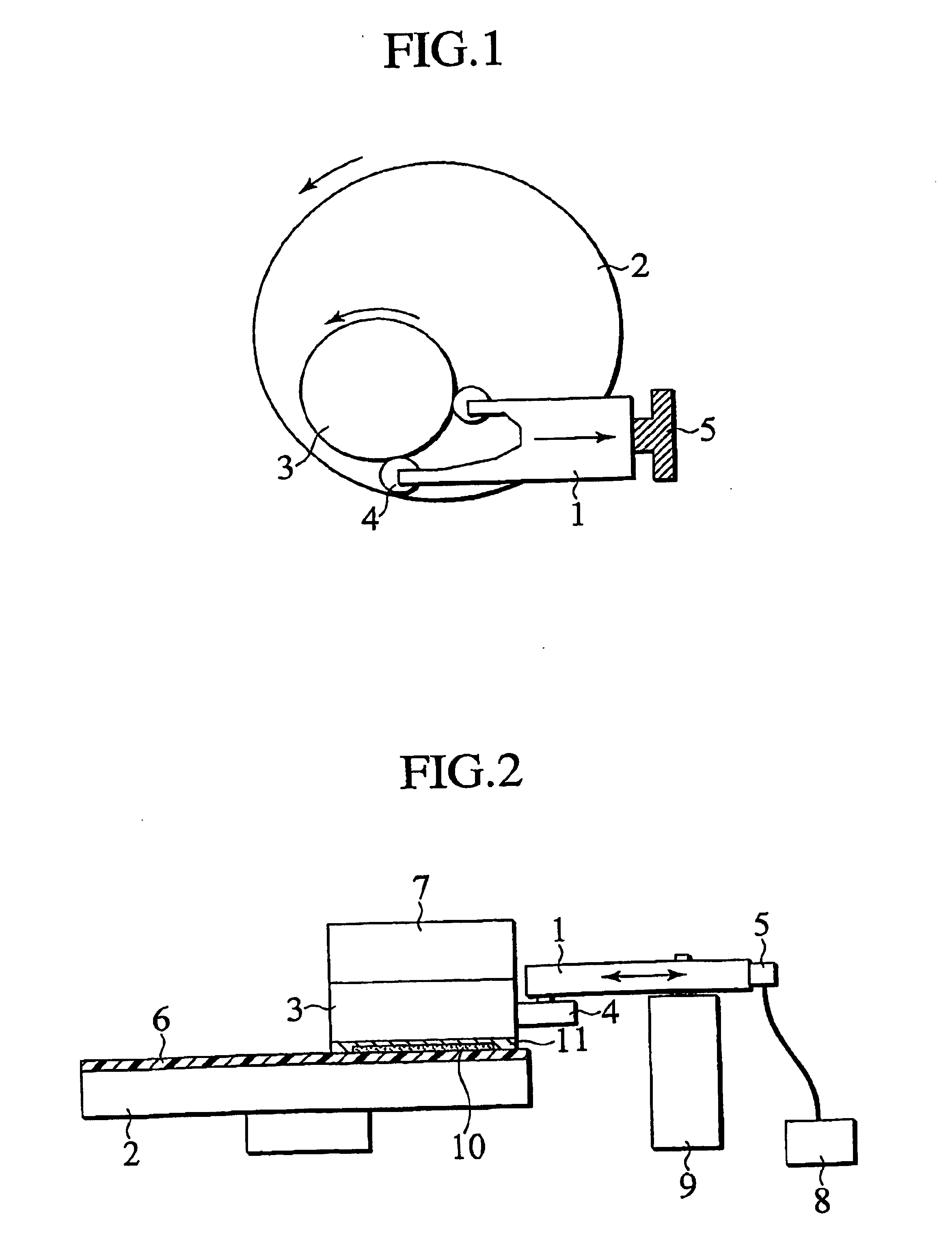Polishing fluid and polishing method
a technology of polishing fluid and polishing method, which is applied in the direction of lapping machines, other chemical processes, water dispersions, etc., can solve the problems of affecting the flattening effect, the surface of the metal oxide film is more oxidized by the oxidant, and the difficulty of fine processing of copper alloys
Active Publication Date: 2005-08-18
HITACHI CHEM CO LTD
View PDF6 Cites 60 Cited by
- Summary
- Abstract
- Description
- Claims
- Application Information
AI Technical Summary
Benefits of technology
The present invention relates to a polishing slurry and a polishing method. The polishing slurry includes an oxidant, a metal oxide dissolver, a metal inhibitor, and water. The metal inhibitor can be a compound with a triazole skeleton, a pyrimidine skeleton, an imidazole skeleton, a guanidine skeleton, a thiazole skeleton, or a pyrazole skeleton. The polishing method involves using the polishing slurry for polishing a metal surface. The technical effects of the invention include improved polishing efficiency, reduced damage to the metal surface, and improved surface quality.
Problems solved by technology
However, these copper alloys have difficulties in fine processing carried out by a dry etching method which is frequently used to form conventional aluminum alloy wiring.
However, if the oxide layer on the surface of the metal film in the concave parts is also etched and the surface of the metal film is thereby exposed, the surface of the metal oxide film is more oxidized by the oxidant.
The repetition of this process leads to the progress of etching of the metal film in the concave parts and there is therefore a fear that the flattening effect is impaired.
However, the formation of wiring by conventional CMP poses the problems, for example, (1) the occurrence of a phenomenon (dishing) that the center part of the surface of the embedded metal wiring is isotropically etched to form a dish-like cave and the occurrence of a phenomenon (erosion or thinning) that the dielectric film is also etched in a part having high wiring density and the thickness of the metal wiring is reduced, (2) the occurrence of polishing scratches, (3) a complicated washing process used to remove a polishing residue left on the surface of the base body after the base body is polished, (4) increased cost caused by waste fluid treatment and (5) corrosion of metals.
However, these barrier layer conductive film has higher hardness than copper or a copper alloy and a combination of polishing materials used for copper or a copper alloy therefore fails in obtaining sufficient CMP rate, giving rise to the problem that dishing of copper or a copper alloy is caused, which decreases the thickness of the wiring during the removal of the barrier layer by CMP.
In the acidic range, however, copper or copper alloy wiring is easily corroded.
However, because these interlayer films and laminate film structure using these interlayer films have small mechanical strength, wiring inferiors are easily caused by, for example, peeling at the boundary between laminate films.
As regards the polishing slurry used to polish copper or a copper alloy, if the concentration of the corrosion inhibitor is increased when an acid having a low pKa is used and the concentration of the metal oxide dissolver is increased to obtain a high polishing rate, the coefficient of polishing friction (coefficient of dynamic friction) during polishing tends to be increased, giving rise to problems concerning, for example, peeling and wire breaking of metal wiring and its laminate film structure.
Also, a rise in temperature caused by friction leads to an increase in the chemical etching effect of the polishing slurry, causing the metal wiring to be etched, posing problems, for example, large dishing.
On the other hand, when an acid which has a high pKa and is hence less corrosive is used and the concentration of the metal oxide dissolver is dropped, there is the problem that only insufficient polishing rate is obtained.
Also, when the pH of the polishing slurry is increased, only insufficient polishing rate is obtained.
Method used
the structure of the environmentally friendly knitted fabric provided by the present invention; figure 2 Flow chart of the yarn wrapping machine for environmentally friendly knitted fabrics and storage devices; image 3 Is the parameter map of the yarn covering machine
View moreImage
Smart Image Click on the blue labels to locate them in the text.
Smart ImageViewing Examples
Examples
Experimental program
Comparison scheme
Effect test
examples
[0114] The present invention will be explained by way of examples, which, however, are not intended to be limiting of the present invention.
the structure of the environmentally friendly knitted fabric provided by the present invention; figure 2 Flow chart of the yarn wrapping machine for environmentally friendly knitted fabrics and storage devices; image 3 Is the parameter map of the yarn covering machine
Login to View More PUM
| Property | Measurement | Unit |
|---|---|---|
| pKa | aaaaa | aaaaa |
| gross weight | aaaaa | aaaaa |
| gross weight | aaaaa | aaaaa |
Login to View More
Abstract
A polishing slurry including an oxidant, a metal oxide dissolver, a metal inhibitor and water and having a pH from 2 to 5. The metal oxide dissolver contains one or more types selected from one or more acids (A-group) selected from acids of which the dissociation constant (pKa) of a first dissociable acid group is less than 3.7 and from which five acids of lactic acid, phthalic acid, fumaric acid, maleic acid and aminoacetic acid are excluded, ammonium salts of the A-group and esters of the A-group, and one or more types selected from one or more acids (B-group) selected from acids of which the dissociation constant (pKa) of a first dissociable acid group is 3.7 or more and the five acids, ammonium salts of the B-group and esters of the B-group. The metal inhibitor contains one or more types selected from the group consisting of aromatic compounds having a triazole skeleton and one or more types selected from the group consisting of aliphatic compounds having a triazole skeleton and compounds having any one of pyrimidine skeleton, imidazole skeleton, guanidine skeleton, thiazole skeleton and pyrazole skeleton. The polishing slurry having a high metal-polishing rate, reducing etching rate and polishing friction, results in the production, with high productivity, of semiconductor devices reduced in dishing and erosion in metal wiring.
Description
BACKGROUND OF THE INVENTION [0001] 1. Field of the Invention [0002] The present invention relates to a polishing slurry, particularly, a polishing slurry used in a process of forming wiring of a semiconductor device and to a polishing method using the polishing slurry. [0003] 2. Description of the Related Art [0004] New technologies for fine processing have been recently developed along with the development of highly integrated and high performance semiconductor integrated circuits (LSIs). A Chemical mechanical polishing method (hereinafter referred to as CMP) is among these technologies and is techniques which are being frequently utilized to flatten an interlayer dielectric film, to form a metal plug and to form embedded wiring in a process of producing LSIs and, particularly, a process of forming multi-layer wiring. These techniques are disclosed in, for example, U.S. Pat. No. 4,944,836. [0005] In recent years, an attempt has been made to utilize copper alloys as wiring materials...
Claims
the structure of the environmentally friendly knitted fabric provided by the present invention; figure 2 Flow chart of the yarn wrapping machine for environmentally friendly knitted fabrics and storage devices; image 3 Is the parameter map of the yarn covering machine
Login to View More Application Information
Patent Timeline
 Login to View More
Login to View More Patent Type & Authority Applications(United States)
IPC IPC(8): B24B37/00C09G1/02C09G1/04H01L21/321
CPCB24B37/0056B24B37/044H01L21/3212C09G1/04C09K3/1463C09G1/02C23F3/06C09K3/14
Inventor KURATA, YASUSHIMASUDA, KATSUYUKIONO, HIROSHIKAMIGATA, YASUOENOMOTO, KAZUHIRO
Owner HITACHI CHEM CO LTD
Features
- R&D
- Intellectual Property
- Life Sciences
- Materials
- Tech Scout
Why Patsnap Eureka
- Unparalleled Data Quality
- Higher Quality Content
- 60% Fewer Hallucinations
Social media
Patsnap Eureka Blog
Learn More Browse by: Latest US Patents, China's latest patents, Technical Efficacy Thesaurus, Application Domain, Technology Topic, Popular Technical Reports.
© 2025 PatSnap. All rights reserved.Legal|Privacy policy|Modern Slavery Act Transparency Statement|Sitemap|About US| Contact US: help@patsnap.com


